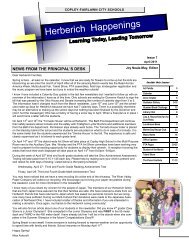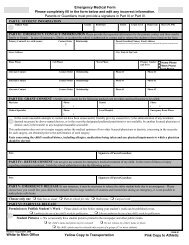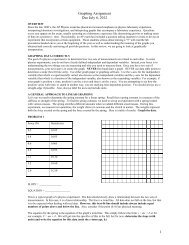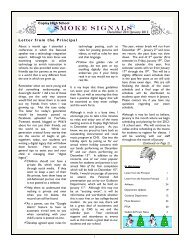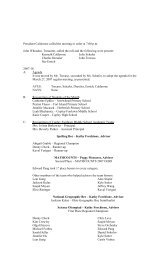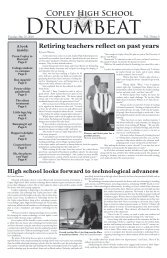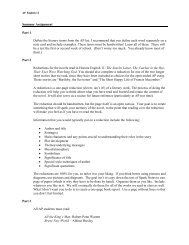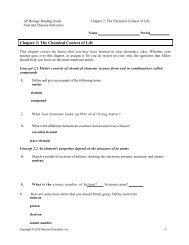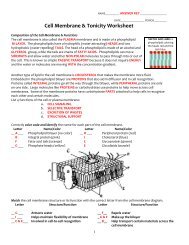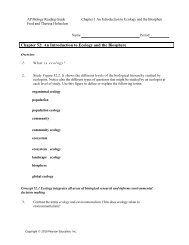AP Studio Art Summer Assignments for 2D Design and Drawing ...
AP Studio Art Summer Assignments for 2D Design and Drawing ...
AP Studio Art Summer Assignments for 2D Design and Drawing ...
You also want an ePaper? Increase the reach of your titles
YUMPU automatically turns print PDFs into web optimized ePapers that Google loves.
<strong>AP</strong> <strong>Studio</strong> <strong>Art</strong> <strong>Summer</strong> <strong>Assignments</strong> <strong>for</strong><br />
<strong>2D</strong> <strong>Design</strong> <strong>and</strong> <strong>Drawing</strong> Portfolio<br />
Laura.addis@copley-fairlawn.org<br />
Preparing <strong>for</strong> the <strong>AP</strong> <strong>Studio</strong> <strong>Art</strong> Class<br />
<strong>Summer</strong> work: Students will meet at the end of the previous school year. To meet the high<br />
aptitude of studio work, summer drawing assignments must be completed by the start of the school year.<br />
Your work outside of class will constitute 50% of your grade throughout the year. This summer<br />
assignment should be taken very seriously <strong>and</strong> you should be approaching each task with the desire to<br />
show your skills <strong>and</strong> creativity to the fullest.<br />
You will need to purchase two drawing pads/books. A visual journal will be required throughout the<br />
year. This will be used to record ideas, thumbnail sketches, design problems, visual inspirations,<br />
swatches of collage images <strong>and</strong> general drawing practice. It should be with you at ALL times. You should<br />
choose the <strong>for</strong>mat (Hardcover, spiral, etc…) of this journal. The hard covered sketchbooks are excellent<br />
when it comes to stability. Just be sure it has good quality paper in it.<br />
(Buy cheap –get cheap!) It pays to get higher quality paper as it will allow you to achieve better results in<br />
your drawings. The second sketchpad should be of good quality paper. 90lb paper weight that is<br />
described as good surface <strong>for</strong> a variety of media is the best bet. This pad should not be larger than<br />
18” x 24”, <strong>and</strong> no smaller than 9” x 12”.<br />
Assignment #1 Fill 35 pages of your new sketchbook. At least half of the sketchbook<br />
assignment will utilize both pages of the book (meaning, the artwork will start on the back of the left<br />
page, across binding <strong>and</strong> connect visually onto the right page.) Refer to the following ideas <strong>and</strong><br />
suggestions:<br />
Pre-prepare many of your pages with washes, newspaper collage, b/w image collage, transfers, etc.<br />
• Draw from imagination<br />
• Record your day through images (like a diary but with pictures)<br />
• Draw self-portraits using different expressions<br />
• Draw to music<br />
• Draw gestures at the pool or in a restaurant on scraps of paper <strong>and</strong> attach to your sketchbook<br />
later<br />
• Pick an “ism from art history <strong>and</strong> draw or paint something that represents it.<br />
• Simply doodle or attach doodles from other places like napkins, notebooks from other classes<br />
• Draw something sitting in front of your… a <strong>for</strong>k, cup food, your h<strong>and</strong>, etc.<br />
• Make abstractions of things from life<br />
• Write r<strong>and</strong>om thoughts, poetry, lyrics, or famous quotes or collaged or water colored paper.<br />
• Attach flyers, postcards, text, graphics that are visually interesting to you.<br />
• Cut out parts of the sketchbook pages to create windows or patterns that reveal the next page.<br />
• Restructure the edges of some pages, add extensions, pop-ups, doors <strong>and</strong> secret compartments.<br />
1
Assignment #2 image collection<br />
• Bring 30 examples of images that are interesting to you <strong>for</strong> the first week of school. They can<br />
be collected in 2 ways: photos taken by you or photos torn from magazines or whatever.<br />
Avoid the internet unless your printer is awesome!<br />
Assignment #3<br />
PART I: REGISTER WITH COLLEGE BOARD<br />
PART II: CHOOSE A FAVORITE PORTFOLIO, WRITE.<br />
PART I: GETTING REGISTERED AT THE COLLEGE BOARD WEBSITE<br />
Register at www.collegeboard.com<br />
Here you will find in<strong>for</strong>mation about <strong>AP</strong> <strong>Studio</strong> <strong>Art</strong> classes, the exam, scoring rubrics<br />
used, <strong>and</strong> examples of past student work in each of the portfolio areas.<br />
·From the www.collegeboard.com homepage, click on the “For Students” tab on the top<br />
left.<br />
·Under “My organizer” you can create a free user account – you can use this account to<br />
access in<strong>for</strong>mation about any <strong>AP</strong> exams <strong>and</strong> classes<br />
·Under the “College Board Tests” section, you can click on “<strong>AP</strong>” which will take you to<br />
the <strong>AP</strong> homepage<br />
·Here is a direct link to the <strong>AP</strong> subjects homepage, where you will find links to all of the<br />
<strong>AP</strong> course descriptions:<br />
http://www.collegeboard.com/student/testing/ap/subjects.html<br />
·Here is a link to the <strong>Studio</strong> <strong>Art</strong> homepage:<br />
http://www.collegeboard.com/student/testing/ap/sub_studioart.html?studioart<br />
PART II: CHOOSE A FAVORITE PORTFOLIO, LOOK AT THE STUDENT SAMPLES, COMMENTARIES<br />
IN CONCENTRATION AND STUDY THE SCORING RATIONALES FOR EACH SECTION. PRINT A<br />
COPY AND BRING TO CLASS.<br />
Go to the <strong>AP</strong> website <strong>and</strong> view the following pages: Concentration <strong>and</strong> Breadth student<br />
samples, student commentaries in concentration <strong>and</strong> the scoring rationales <strong>for</strong> each<br />
section.<br />
Here’s the web address <strong>and</strong> how to navigate from the home page:<br />
http://apcentral.collegeboard.com/apc/public/courses/index.html<br />
From this page, scroll over the green button on the left of the page “<strong>AP</strong> courses <strong>and</strong><br />
exams” <strong>and</strong> click on “Course Home Pages”. Click on <strong>Studio</strong> <strong>Art</strong>: <strong>Drawing</strong> at the bottom<br />
of the page. Then go to “<strong>AP</strong> <strong>Studio</strong> <strong>Art</strong>: <strong>Drawing</strong> Portfolio with Student Samples <strong>and</strong><br />
Scoring Guidelines”. Then, click on the links <strong>for</strong> Quality with student examples,<br />
Concentration with Student examples <strong>and</strong> Breadth with student examples <strong>and</strong> become<br />
familiar with these examples, the scores that each received <strong>and</strong> reasons <strong>for</strong> the scores.<br />
For the writing assignment, choose a year to review <strong>for</strong> each portfolio (quality, breadth<br />
<strong>and</strong> concentration) <strong>and</strong> answer the following questions:<br />
Write down the year you chose, student name <strong>and</strong> score <strong>for</strong> each portfolio <strong>for</strong> that<br />
section (ex. 2008 Concentration- Mary Smith, score-6, Joe Jones, score-5, Sally Martin,<br />
2
score 4).<br />
These questions should be used <strong>for</strong> each portfolio: quality, breadth <strong>and</strong> concentration.<br />
1. In the portfolio that scored a 6 what did you feel was most successful <strong>and</strong> why?<br />
2. In general, what was the biggest difference between the portfolio that received a 6<br />
<strong>and</strong> the one that received a 5?<br />
3. Analyze the composition of one of the images in the portfolio that scored a 6. How<br />
does the student create a focal point? How is the composition organized to lead the<br />
viewer’s eye from one place in the image to another?<br />
4. What did the judges respond to in terms of technique, media, composition, color,<br />
subject <strong>and</strong> content in the 6 portfolio?<br />
5. What is 1 main difference from portfolio that scored a “6” from the one that scored a<br />
“5” <strong>and</strong> the one that scored a “4”?<br />
6. What is one major weakness in the 4 portfolio (in your opinion <strong>and</strong> based on the<br />
explanation from the judges)? What could that student have done to improve the work?<br />
7. Looking at the commentary <strong>for</strong> the 6 portfolio in the Concentration section, How does<br />
the student clearly describe his/her work so that you can see their ideas in the work?<br />
8. What is one thing from the 6 portfolio that will be important to keep in mind <strong>for</strong> your<br />
portfolio? What is one thing from the 4 portfolio that you will work to avoid?<br />
Why is this important? The more you know about how previous student have achieved<br />
<strong>and</strong> what the judges have responded to, the better equipped you will be as you begin<br />
your work<br />
PRINT A COPY AND BRING TO CLASS<br />
Your summer work should be planned in the journal <strong>and</strong><br />
completed on the larger paper sketchbook.<br />
It is highly recommended that you investigate ideas on developing strong compositions. Study the<br />
importance of the elements <strong>and</strong> principles of design.<br />
The internet is full of ideas <strong>and</strong> descriptions.<br />
Whenever possible, draw directly from life, not from photographs or other reference images.<br />
If you must use printed images, save them with your completed work.<br />
<strong>Assignments</strong> 4-6 :<br />
<strong>AP</strong> <strong>Studio</strong> <strong>Art</strong> <strong>Summer</strong> <strong>Assignments</strong><br />
These assignments are geared to meet the requirements <strong>for</strong> the BREADTH*<br />
section of the <strong>AP</strong> Exam. This section should be a sample of various<br />
drawing skills, techniques <strong>and</strong> show a variety of media use.<br />
3
If you feel you would like to do work based on your CONCENTRATION*<br />
theme you can use these same assignments as a guide <strong>for</strong> different<br />
approaches to that theme.<br />
Do at least Three intensive<br />
drawings/paintings/mixed media of the following<br />
possibilities:<br />
( If you have time <strong>and</strong> the motivation to complete more than three<br />
<strong>Assignments</strong> – GREAT!! You’ll receive extra credit. However please don’t think of<br />
quantity as the grade achievement.<br />
Quality is much more important in each drawing. Push<br />
yourself to a higher level with each assignment. A<br />
successful piece can be used as a QUALITY* piece on the<br />
exam.<br />
DON’T WAIT UNTIL THE LAST MINUTE! It will show in your work.<br />
Failure to submit the summer assignments will be taken as a true sign of your lack of<br />
commitment to this class. Your year will begin with a failing grade.<br />
* These are the three categories that are required <strong>for</strong> the<br />
<strong>AP</strong> Exam submissions.<br />
Refer to the <strong>AP</strong> Poster <strong>for</strong> details on the requirements <strong>for</strong><br />
the exam. A new poster will be available to you in the Fall.<br />
4
For more details about <strong>AP</strong> <strong>Studio</strong> <strong>Art</strong> Requirements,<br />
please see:<br />
http://www.collegeboard.com/student/testing/ap/sub_studioart.html?studioart<br />
http://www.collegeboard.com/ap/studioart/rubrics00/studio_breadth_drawing.html<br />
1. PORTRAIT / FIGURE CHOICES:<br />
A. PORTRAIT: METAMORPHOSIS!<br />
Step 1. BRAINSTORM WITH LISTS:<br />
If you could be anything or anyone in the world, who or what would you be?<br />
List 10 things you would change into <strong>and</strong> the reasons <strong>for</strong> your choices.<br />
Step 2. PHOTOGR<strong>AP</strong>H YOURSELF & WHAT YOU’D CHANGE INTO.<br />
Get a total of 24 shots of yourself <strong>and</strong> the object/person you would like to change into. It can be any<br />
combination. You can use a tripod <strong>and</strong>/or get help from a friend to shoot self-portraits. Remember<br />
that you will need to get a signed release <strong>for</strong>m from the photographer, if it is not yours, <strong>and</strong> that you<br />
are not to use copy written images from the internet or books (<strong>AP</strong> guidelines are strict.)<br />
Step 3. EXAMINE THE PHOTOGR<strong>AP</strong>HS FOR TRANSITION:<br />
Set aside 6 – 8 strong c<strong>and</strong>idates that show transition without strong jumps. These will be the basis<br />
<strong>for</strong> a collage or sequence showing the transition.<br />
Step 4. CREATE SIX SMOOTH TRANSITIONAL STEPS TO SHOW FINAL<br />
METAMORPHOSIS.<br />
*What media do you feel com<strong>for</strong>table in making the changes to these shots?<br />
*(Will photoshop be an appropriate choice <strong>for</strong> you to blend some of the images, distort them or<br />
tweak the color?<br />
*Do you need to use the photocopier as a tool to lighten or darken them, shrink them, enlarge them,<br />
or blur them?<br />
*Do you need to touch them up with pencil to strengthen the sequence of change.<br />
*Do you need to tear <strong>and</strong> collage the images together add watercolor, oils, tempera, or acrylic.<br />
Step 5. FINAL WORK WILL BE EITHER A SEQUENCE OF IMAGES OR A COLLAGE<br />
IMAGE. Size will vary but likely include 3 to 5, 8x10 digital images, or a 14 x 17 or 18 x 24 mixed<br />
media work.<br />
B. PORTRAIT: CONCEPTS <strong>for</strong> <strong>2D</strong> &/or DRAWING:<br />
All pencil, colored pencil, charcoal, or pastel drawings must use a 10 point value scale with a wide<br />
range of strong darks <strong>and</strong> lights. Strong lighting can be used to achieve this dramatic effect.<br />
*Self-portrait with at least 5 distinct changes in expression. (<strong>2D</strong> or Draw.)<br />
*Draw the person using an arrangement of drawings on one page that range from the whole body to<br />
blow-ups of small details. (<strong>2D</strong> or Draw.)<br />
*Draw from unusual angles, so that significant changes in <strong>for</strong>m take place due to <strong>for</strong>eshortening. (<strong>2D</strong><br />
or Draw.)<br />
*Look up Self-portraits on Google to see the different styles, techniques <strong>and</strong> approaches that<br />
different artists have used.<br />
*Experiment with Lighting: hold a flashlight to create dramatic shading- great contrasts in light or<br />
dark. (<strong>2D</strong> or Draw.)<br />
*Integrate a particular person’s face into a pattern or design. (<strong>2D</strong> or Draw.)<br />
* Using markers, Prismacolors, oil pastels or some other color drawing material, draw the same<br />
portrait twice, but use two different color schemes. (ie: warm, cool, monochromatic, analogous,<br />
primary or secondary.) (<strong>2D</strong>)<br />
*Graph sections of the portrait <strong>and</strong> color or shade only certain sections. (<strong>2D</strong> or Draw.)<br />
5
*Draw a portrait using only directional (all strokes going in the same direction.) or vertical strokes.<br />
See the work of Renaissance artists like Michelangelo or Leonardo DaVinci. (<strong>2D</strong> or Draw.)<br />
*Create a portrait starting with the background first. Use toned paper, newspaper or magazines, <strong>and</strong><br />
gesso, then drybrush ink onto the surface to create details. (<strong>2D</strong>)<br />
*Draw a portrait with h<strong>and</strong>s involved: brushing hair, reading a book, sitting on a chair backwards<br />
with the h<strong>and</strong>s in front. (<strong>2D</strong> or Draw.)<br />
*Use the portrait to make a comment on society by including appropriate background or other<br />
figures. (<strong>2D</strong> or Draw.)<br />
*Portrait emerging from robes or wrapping. (<strong>2D</strong> or Draw.)<br />
2. STILL LIFE CHOICES:<br />
A. Portrait: Metamorphosis!<br />
Still life objects can be substituted instead of a portrait.<br />
B. TOOLS & HARDWARE. (<strong>2D</strong> or Draw.)<br />
Make a rendering of tools <strong>and</strong> hardware. Arrange the objects to create an engaging composition.<br />
Stress the mechanical <strong>and</strong> artificial qualities of the objects. Augment the lighting to create maximum<br />
contrast <strong>and</strong> high shine areas. Explore the smallest detail of each object. Use white paper with<br />
permanent marker (scribble line, stippling, or cross hatching)<br />
C. LIQUID AS DESIGN. (<strong>2D</strong> or Draw.)<br />
Taking Motivation from any liquid <strong>for</strong>m, create a composition, which demonstrates the scientific<br />
characteristics of liquid; flowing, dripping, puddles, pouring. Be sure to make the liquid element<br />
dominate the composition. Do not allow containers or other items to crowd the setting. Use dark<br />
color paper with any color media.<br />
D. SHINING STILL LIFE, with emphasis on REFLECTION. (<strong>2D</strong><br />
Draw.)<br />
Choose five to seven objects, of which at least two of them have a highly polished surface. The<br />
relationship among objects should be a serious consideration in this drawing. The surface treatment<br />
of each object will appear stronger if the objects chosen have different surface textures. Use grey <strong>and</strong><br />
white paper with black <strong>and</strong> white medium.<br />
E. BOTTLE & CONTAINERS, with emphasis on Value.<br />
(<strong>2D</strong> or Draw.)<br />
Group several different sizes <strong>and</strong> heights of bottles <strong>and</strong> containers on a shelf or counter top. Draw<br />
them as a congregation of people. Give each one of them equal amounts of attention. Convey volume<br />
by using a complete range of tonal changes from deep-deep black up to the pure whiteness of the<br />
paper. Place one or two of them in front of the others to give a sense of space. Ebony pencil with 10<br />
point value scale.<br />
3. LANDSC<strong>AP</strong>E/ VEGETATION/ NATURE CHOICES:<br />
6
A. DRAWING OF VEGETATION. (<strong>2D</strong> or Draw.)<br />
This drawing should make a close investigation of the structure of vegetation. Color variation is an<br />
important element to stress. Placement on the page <strong>and</strong> rendering are also principles to be employed.<br />
Use colored chalk pastels or colored pencils. Colored paper may enable a greater amount of success.<br />
B. LANDSC<strong>AP</strong>E COLLAGE. (<strong>2D</strong>)<br />
Make a collage of a l<strong>and</strong>scape, which has a wooded scene, flowers, <strong>and</strong> foliage.<br />
Cut <strong>and</strong> tear papers of various textures <strong>and</strong> colors to create a sense of dimension.<br />
Use shadow areas. These papers could consist of magazine color swatches, sections of sample water<br />
paintings, wallpaper, or photographs you’ve taken.<br />
C. POTTED PLANT or GARDEN PLANT: (<strong>2D</strong> or Draw.)<br />
Make a detailed drawing of a plant (living or artificial). Grade the tonal differences between the<br />
leaves, which are above or on top of others. Make it obvious that some parts of the plant are in<br />
shadows created by those parts which are receiving more direct light. This drawing must touch three<br />
edges of the page. Medium: Ebony Pencil, Colored pencils, chalk pastels, permanent marker using<br />
stippling, scribble line, or cross hatching with watercolor accents.<br />
D. MECHANICAL IMITATION of NATURE. (3D)<br />
Create an item from nature using very constructive, manmade materials. Examples: flowers made of<br />
metal bolts, <strong>and</strong> nails, an animal constructed with computer parts, a human figure made of glass<br />
bottles. It may be your desire to combine several small items to create an ensemble of sculptures.<br />
Height: 10” minimum excluding the base.<br />
E. SALAD COLLAGE - Fruit or Vegetable. (<strong>2D</strong> or 3D)<br />
Slice some vegetables or fruit in half. Examine the layers <strong>and</strong> curves <strong>and</strong> seeds that a pepper, an<br />
onion, a mushroom, an orange, a pomegranate, or apple might have. Create a collage using cut<br />
colored paper, or photocopies/scanned images of the slide items. Distort them; shrink them using the<br />
computer or photocopier. They can be h<strong>and</strong>-colored using Berol Prismacolor markers.<br />
To create a three-dimensional relief or sculpture, layers can be built up using foam core board <strong>and</strong><br />
toothpicks to achieve strength <strong>and</strong> height.<br />
*Close ups <strong>and</strong> sections of these can also serve as studies <strong>and</strong> inspirations <strong>for</strong> enameled jewelry.<br />
F. LANDSC<strong>AP</strong>E SERIES- Same Spot-Different Time.<br />
(<strong>2D</strong> or Draw)<br />
Check out Claude Monet’s haystacks on line. Why did Monet literally paint the same haystacks<br />
over <strong>and</strong> over again? He even begged the farmer who badly wanted to use the hay, not to move them.<br />
To under underst<strong>and</strong> the beauty of color, reflection, <strong>and</strong> light, get up early <strong>and</strong> examine the colors of<br />
one outdoor object. It can be a shed, a compost pile, some bushes, Examine that same thing three<br />
hours later, then three hours later. Something that appeared black in the morning, then can look<br />
purple, then blue, then gold. These changes can occur all in the same day, depending upon weather<br />
<strong>and</strong> seasonal conditions. Create series of at least three paintings or drawings of the same scene at<br />
different times of the day depicting the actual colors that moment.<br />
3. ARCHITECTURE/ INTERIOR & EXTERIOR DESIGN/<br />
PERSPECTIVE:<br />
A. INTERIOR SPACE. (<strong>2D</strong> or Draw.)<br />
7
Place yourself in the corner of an interior space. Create a composition which is<br />
made up of the things you find within the limited area of a room or hallway. Demonstrate the<br />
principles of balance <strong>and</strong> spatial movement within this area. Medium suggestions- Berol Prismacolor<br />
Markers, cut paper, oil pastels, oil paint, colored pencils.<br />
B. FENCES & GATES: (<strong>2D</strong> or Draw.)<br />
<strong>Drawing</strong> fences <strong>and</strong> gates will help you apply <strong>and</strong> underst<strong>and</strong> linear perspective. Position yourself so<br />
that a strong exaggeration of the contour lines occurs. Draw the characteristics of the fence/ gate as<br />
realistically as possible. Pay attention to joint areas <strong>and</strong> attachments. Ebony Pencils or Permanent<br />
Marker using scribble line, cross hatching or stippling.<br />
C. ARCHITECTURALLY INSPIRED JEWELRY OR CLAY<br />
SCULPTURE: (<strong>2D</strong>, 3D, Draw.)<br />
<strong>Design</strong> a series of earrings or clay sculpture that is inspired by an architectural element such as a<br />
hinge, a door, door knob, window, window latch, chair, a street lamp, or a metal window grate.<br />
Abstract the <strong>for</strong>m, repeat the motif or element to create a whole new idea.<br />
Assignment #7<br />
Contemporary <strong>Art</strong>ist Research<br />
Requirements:<br />
• Explore the work of 3 or more contemporary 3‐D artists<br />
• Address 3 areas about the artist <strong>and</strong> their work:<br />
1. Give some background in<strong>for</strong>mation on the artist<br />
2. Describe the artists’ work<br />
3. React to the artists’ work<br />
• Include printed images/text as well as your own descriptive<br />
drawing/writing of the artist’s work<br />
• Use as many pages as needed in your sketchbook on each artist<br />
Assignment #8<br />
Gallery or <strong>Art</strong> Exhibition Review<br />
Requirements:<br />
• Explore one or more galleries/exhibitions <strong>and</strong> share your thoughts<br />
• Address these areas:<br />
8
1. Name, title, location, general in<strong>for</strong>mation, date viewed<br />
2. Describe, react <strong>and</strong> share your overall experience; reflect on<br />
the overall body of work shown<br />
3. Discuss three or more specific pieces that affected you both<br />
positively or negatively<br />
4. Include printed images/text as well as your own descriptive<br />
drawing/writings of the gallery/exhibition<br />
5. Use as many pages as needed in your sketchbook<br />
9





